Global Temporary Power Market - Comprehensive Data-Driven Market Analysis & Strategic Outlook
The global temporary power market will keep itself molded as a dynamic solution for power issues that the conventional infrastructures cannot tackle right away. As populations shift towards more industrial pursuits, urban growth, and event-based demand, temporary power will no longer be a short-term solution but will come to act as a strategic component in power planning. In the future, governments and companies will have to turn to temporary power as a stopgap to sustainability, particularly when renewable integration is delayed or there are technical constraints.
- Global temporary power market valued at approximately USD 9.8 billion in 2025, growing at a CAGR of around 10.5% through 2032, with potential to exceed USD 19.6 billion.
- Diesel account for nearly 70.5% market revenues, driving innovation and expanding applications through intense research.
- Key trends driving growth: Increasing frequency and severity of natural disasters and grid outages., Rising demand from construction, events, and film industries for flexible power.
- Opportunities include Rapid adoption of silent, zero-emission battery-based temporary power systems.
- Key insight: The market is set to grow exponentially in value over the next decade, highlighting significant growth opportunities.
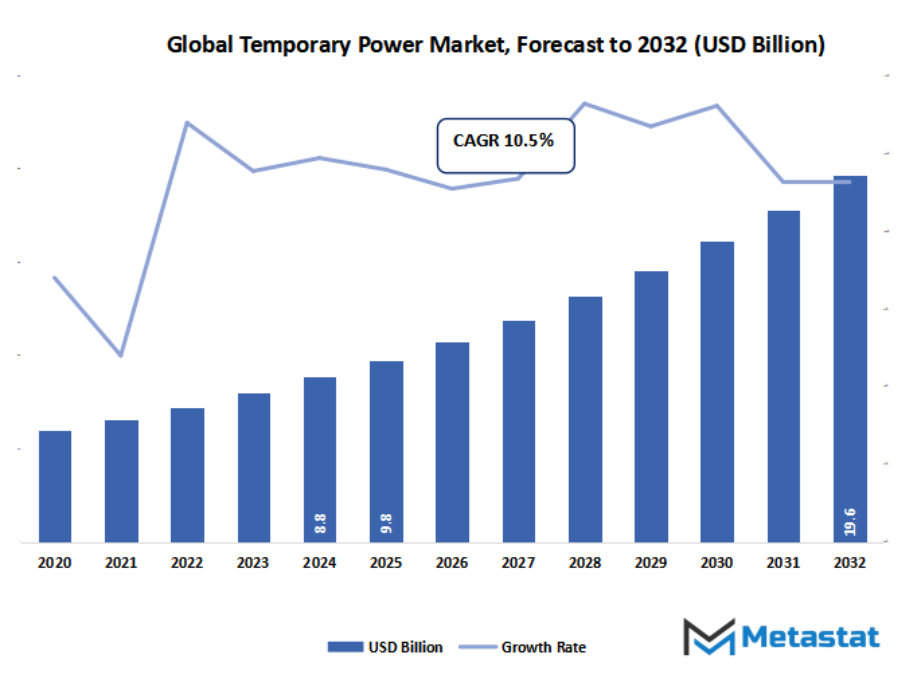
What function will renewable integration play in reshaping the global temporary power market, how would possibly stricter environmental guidelines disrupt the dominance of diesel generators, and could growing call for from developing economies create new opportunities for innovative and sustainable power solutions?
The sector will slowly transform into a sector that reconciles both crisis needs and long-term flexibility. Temporary power solutions will grow more intelligent and responsive, making them precious not only in the time of crisis but also in scheduled situations where flexibility is needed. This transformation will achieve a future that will have temporary solutions stabilizing industries, communities, and infrastructure projects by providing assured energy access at key points.
What is outside the immediate horizon of the global temporary power market will be the integration of temporary and fixed infrastructures. This fusion will enable energy suppliers to address increasing complexity of demand without relying on inflexible networks. In areas where the grids are still developing, temporary power will be the first layer of advancement, eventually integrating with fixed systems. For industrialized economies, it will be a cushion that provides stability while extensive energy transformations are in progress.
Market Segmentation Analysis
The global temporary power market is mainly classified based on Fuel Type, End-use.
By Fuel Type is further segmented into:
- Diesel - Diesel-based solutions within the global temporary power market will remain to serve as good backup where robust performance and quick response are essential. While sustainability issues might restrict large-scale use, advancing fuel efficiency and emission decrease technologies will permit diesel systems to continue being of prime importance in industrial and utility applications on a large scale.
- Gas - Gas-fired temporary power generation will see greater uptake considering cleaner combustion and long-term cost benefits. The global temporary power market will adopt innovative gas turbines and modular generators that will fit into areas with a focus on sustainability while being available for secure flexibility in times of crisis, events, and infrastructure development.
- Others - Alternative power sources, such as hybrids and renewables, will see expanded use in the global temporary power market. Solar, battery storage, and advanced hybrid units, integrated with each other, will offer low-carbon, portable power alternatives. Such alternatives will be used to power industries, and event installs where environmental concern, operational effectiveness, and noise control are the main considerations in the future.
By End-use the market is divided into:
- Utilities - Utilities in the global temporary power market will use temporary generation to cover power shortages in cases of grid failure, maintenance, or high demand spikes. With energy demand still growing, utilities will increasingly use mobile solutions as part of their contingency planning, providing uninterrupted supply while longer-term infrastructure developments are in progress.
- Oil & Gas - Oil and gas activities will rely on temporary generation for drilling operations, exploration locations, and offshore platforms. The global temporary power market will become a vital facilitator, providing uninterrupted operations even in hard-to-reach and extreme locations. Implementation of hybrid and efficient mobile solutions will improve energy reliability and minimize downtime.
- Construction & Mining - Construction and mining locations, which are frequently remote from permanent infrastructure, will spur the major demand in the global temporary power market. Temporary power generation units will provide the electricity needed by machinery, lighting, and communications systems. Emerging developments will feature tough and light transportable units, capable of withstanding high-demand applications with a minimum of interruptions.
- Events - Portable power generation will continue to serve big events, exhibitions, and outdoor events. The global temporary power market will grow in this segment by providing quieter and low-emission power solutions especially suited for public environments. Greater mobility, quicker installation, and incorporation of renewable power sources will define event-based energy deployment strategies of the future.
- Others - Other uses in the global temporary power market will be for disaster relief, remote field applications, and military operations. All these environments will need reliable and rapid-deployment options. Hybrid and renewable-integrated solutions will be the leaders here, providing flexible, light-weight, and eco-friendly energy sources that adjust to changing situational requirements across industries and communities.
|
Forecast Period |
2025-2032 |
|
Market Size in 2025 |
$9.8 billion |
|
Market Size by 2032 |
$19.6 billion |
|
Growth Rate from 2025 to 2032 |
10.5% |
|
Base Year |
2024 |
|
Regions Covered |
North America, Europe, Asia-Pacific, South America, Middle East & Africa |
Geographic Dynamics
The global temporary power market has drawn interest in the past few years as events, infrastructure projects, and industries increasingly become dependent on flexible power solutions. Temporary power is crucial when permanent supply cannot be had or is lacking, thus proving useful in construction sites, relief efforts following disasters, and mass events. As there is more demand for constant electricity, the demand for reliable temporary power sources will continue to grow globally. This requirement is not for a single location since every region has its own application of temporary power according to local needs and economic activity.
In North America, the United States of America, Canada, and Mexico provide a sound foundation for the market due to regular application of standby power in industries and during natural disasters. The U.S., specifically, is highly demanding because it has a vast commercial sector and a large number of infrastructure projects. Canada comes closely behind, having industries that are dependent on energy stability, whereas Mexico experiences more adoption as the nation focuses on developing its infrastructure. Collectively, these countries form North America as one of the significant players in the global temporary power market.
Europe is also a major contributor, with nations such as the UK, Germany, France, and Italy displaying stable demand. All these nations employ temporary power solutions not just for industrial applications but also for public events and disaster relief. Germany and France, with their robust industrial sector, are particularly significant for stable need for extra energy resources. The UK remains reliant on temporary power for commercial and domestic application, particularly in cases where quick and sure supply is paramount. The remainder of Europe contributes to this expansion, so the region has a consistent presence in the international market.
Asia-Pacific, however, will be one of the quickest-growing regions. India, China, Japan, and South Korea are major investors in infrastructure construction and urbanization, which directly drives temporary power demand. India and China, due to large populations and growing energy consumption, are major growth drivers, with Japan and South Korea having a steady demand due to industrial use and technologically driven projects. The rest of Asia-Pacific also contributes consistently, thus making the region a dominant force in the global market.
Middle East & Africa and South America further demonstrate the global reach of this sector. In South America, Argentina and Brazil are key markets owing to construction activity and the constant need for backup power in far-flung areas. Meanwhile, the Middle East & Africa is characterized by expansion within the GCC Countries, Egypt, and South Africa, where development projects and power deficiencies tend to produce a demand for temporary measures. Both regions cannot compete with the size of North America or Asia-Pacific but remain key contributors to the overall growth of the market.
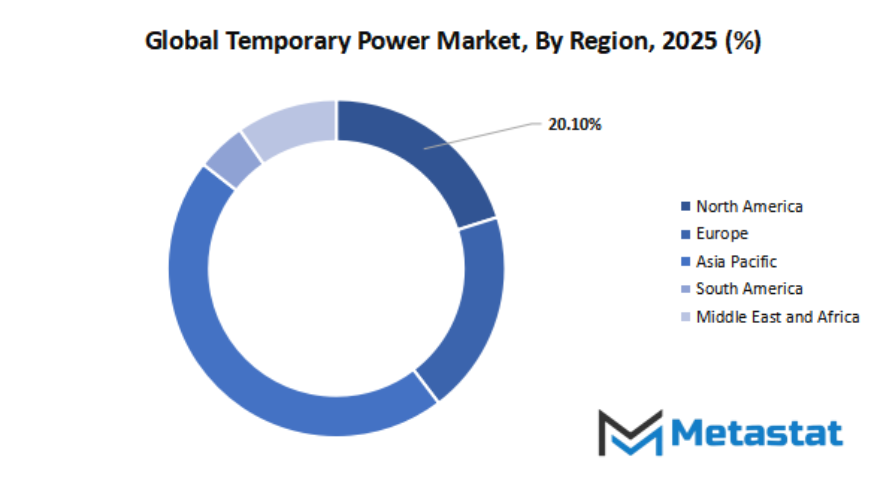
Competitive Landscape & Strategic Insights
The global temporary power market has developed into a vital backup system for industries, construction sites, events, and emergency needs where a stable source of electricity is required for a limited duration. With the increasing demands of energy in various parts of the world, temporary power solutions will remain a critical bridge to cover the gaps where permanent sources of power are lacking or unavailable. The sector is not just fuelled by the urgent need for standby power, but also by the convenience it provides to governments and companies, with operations continuing uninterrupted in times of need.
The market is defined by a combination of established foreign companies and regional new entrants, both with their own set of strengths. Senior gamers like Aggreko PLC, APR Energy PLC, and Caterpillar Inc. Have mounted international reputations through imparting huge-scale, reliable answers. Their enjoy allows them to supply solutions to industries from oil and fuel to infrastructure construction, in which energy requirements can be each immediate and on a huge scale. Meanwhile, local rivals are catching up by customizing services to suit local needs and offering cost-efficient solutions, thereby becoming crucial in the scheme of competition.
Other established players such as Cummins Inc., Ashtead Energy PLC, and Kohler are also strengthening their hold with the delivery of quality products and the strengthening of service networks. Companies like Rental Solutions and Services, Power Electrics, Speedy Hire, and United Rentals further complicate the market by catering to varying customers' needs either for temporary equipment rental or longer-term power projects. The entry by the Hertz Corporation and Smart Energy Solutions is evidence of how businesses of different origins are discovering opportunities within this industry, and its significance in various areas.
In the future, the short-term power market will continue to be a worthwhile business as international infrastructure increases and the need for dependable electricity grows more urgent. With a mix of proven veterans and new players from various regions, competition will remain active, stimulating innovation and efficiency. The future of the market will be defined by the dynamic between multi-billion-dollar international providers and more agile, small-scale players who are able to pick up on local needs in real-time, providing temporary power as a necessary solution to global energy demands.
Market Risks & Opportunities
Restraints & Challenges:
High fuel and maintenance costs for diesel generator-based systems. - The global temporary power market will experience increasing pressure from increasing costs associated with diesel-based systems. With fuel prices steadily changing and equipment being serviced on a frequent basis, long-term utilization will no longer be a cost-effective solution. This issue will motivate industries to look at cleaner, more affordable, and dependable alternatives in the future.
Noise and emissions regulations limiting generator use in urban areas. - Stricter urban regulations will have a profound impact on the global temporary power market. As cities accentuate rules on noise pollutants and toxic emissions, conventional diesel generators will not be the feasible choice. Future calls for will shift to cleaner, quieter alternatives which can be consistent with sustainable urban development.
Opportunities:
Rapid adoption of silent, zero-emission battery-based temporary power systems. - The global temporary power market will pick out up velocity with the emergence of battery-based totally systems that emit not anything and run silently. These advancements will no longer most effective meet regulatory and environmental necessities but also redefine electricity reliability. Future growth may be driven by means of technological advancements and investment in cleaner answers.
Forecast & Future Outlook
- Short-Term (1–2 Years): Recovery from COVID-19 disruptions with renewed testing demand as healthcare providers emphasize metabolic risk monitoring.
- Mid-Term (3–5 Years): Greater automation and multiplex assay adoption improve throughput and cost efficiency, increasing clinical adoption.
- Long-Term (6–10 Years): Potential integration into routine metabolic screening programs globally, supported by replacement of conventional tests with advanced biomarker panels.
Market size is forecast to rise from USD 9.8 billion in 2025 to over USD 19.6 billion by 2032. Temporary Power will maintain dominance but face growing competition from emerging formats.
The global temporary power market will thus go beyond emergency deployment and be an ongoing associate in energy planning globally. Its destiny will be guided by innovation, flexibility, and its capacity to fill the gap between what is presently needed now and what will be secured forever in the future.
Report Coverage
This research report categorizes the Temporary Power market based on various segments and regions, forecasts revenue growth, and analyzes trends in each submarket. The report analyses the key growth drivers, opportunities, and challenges influencing the Temporary Power market. Recent market developments and competitive strategies such as expansion, type launch, development, partnership, merger, and acquisition have been included to draw the competitive landscape in the market. The report strategically identifies and profiles the key market players and analyses their core competencies in each sub-segment of the Temporary Power market.
By Fuel Type:
- Diesel
- Gas
- Others
By End-use:
- Utilities
- Oil & Gas
- Construction & Mining
- Events
- Others
Key Global Temporary Power Industry Players
- Aggreko PLC
- APR Energy PLC
- Ashtead Energy PLC
- Caterpillar Inc.
- Speedy Hire
- Cummins Inc.
- Kohler
- Rental Solutions and Services
- Power Electrics
- United Rentals
- Hertz Corporation
- Smart Energy Solutions
WHAT REPORT PROVIDES
- Full in-depth analysis of the parent Industry
- Important changes in market and its dynamics
- Segmentation details of the market
- Former, on-going, and projected market analysis in terms of volume and value
- Assessment of niche industry developments
- Market share analysis
- Key strategies of major players
- Emerging segments and regional growth potential




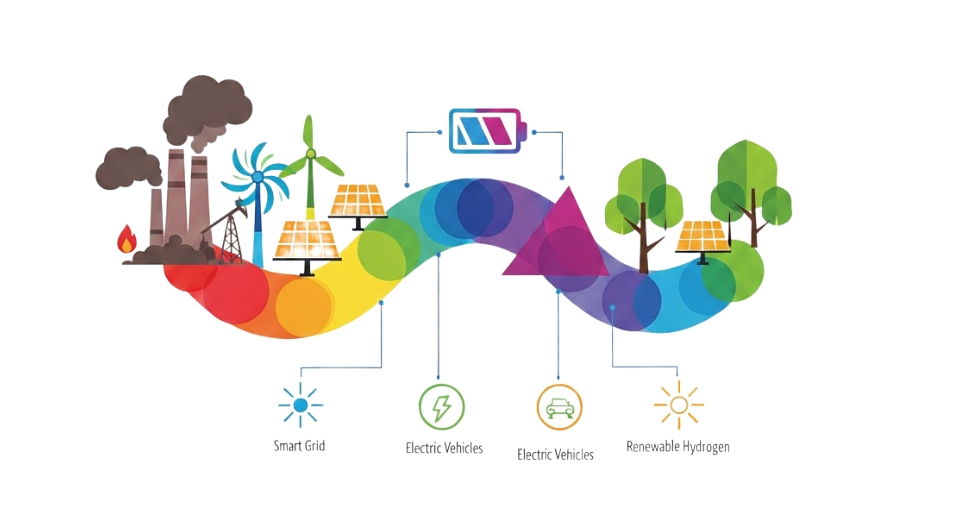
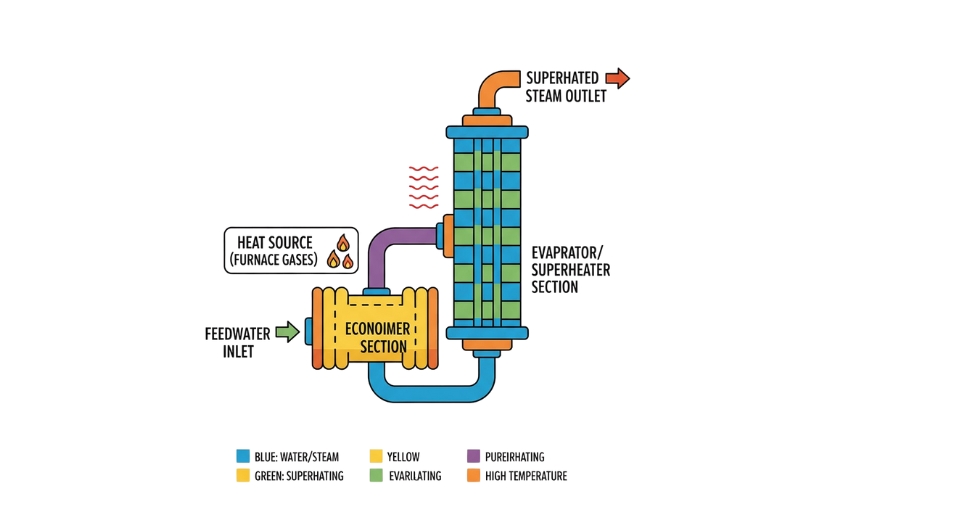
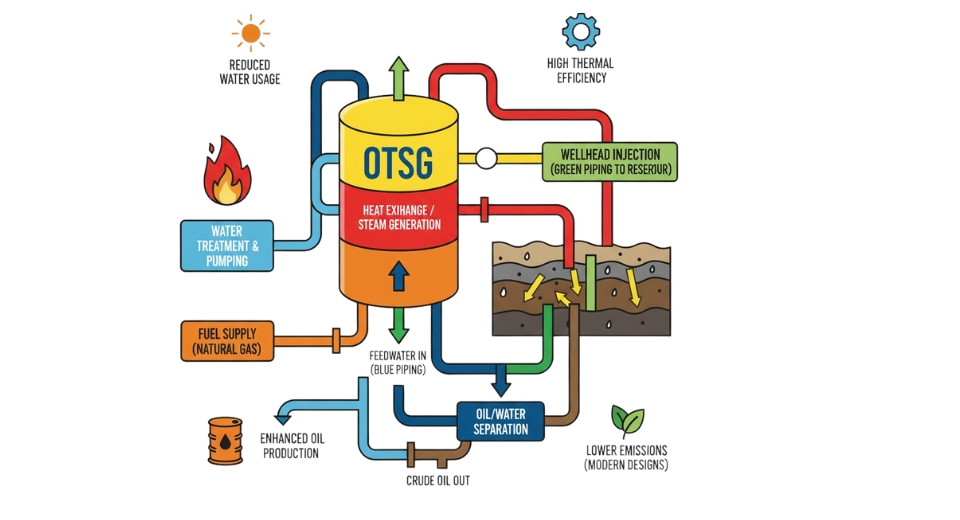

 US: +1 3023308252
US: +1 3023308252






